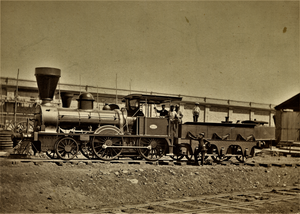South Australian Railways 1-3
South Australian Railways 1, 2 & 3 were the first three locomotives used to pull trains on South Australian Railways on the Adelaide to Port Adelaide line in 1856. Built by William Fairbairn in Manchester they were named Adelaide, Victoria and Albert, later being renumbered 1-3. They were later used on the Adelaide to Kapunda line. These locomotives were originally tank engines but received a tender engine conversion in 1869 to increase their capacity for fuel and water prior to their being withdrawn by 1873.[1][2]
| South Australian Railways 1, 2 & 3 | |||||||||||||||||||||||||
|---|---|---|---|---|---|---|---|---|---|---|---|---|---|---|---|---|---|---|---|---|---|---|---|---|---|
 One of the first three locomotives as rebuilt, 1869 | |||||||||||||||||||||||||
| |||||||||||||||||||||||||
| |||||||||||||||||||||||||
| |||||||||||||||||||||||||
| |||||||||||||||||||||||||
After the locomotives were scrapped, the coupling wheels from numbers 1 and 2 were used as bogies on a well wagon known as The Crocodile built by the Adelaide Locomotive Works. It was used to transport narrow gauge locomotives over the broad gauge to and from Islington Railway Workshops until 1977. One set is on display at the National Railway Museum, Port Adelaide and the other at SteamRanger.[1][3] Parts of number 2 were used in the 1882 assembly of E56.
References
- Turner, Jim (2014). Australian Steam Locomotives 1855-1895. South Windsor: Jim Turner. p. 22. ISBN 9780992497675.
- "Early South Australian locomotive [B 6836] • Photograph". State Library of South Australia. 30 September 2005. Retrieved 22 June 2016.
- Locomotive Wheels National Railway Museum
External links
![]()